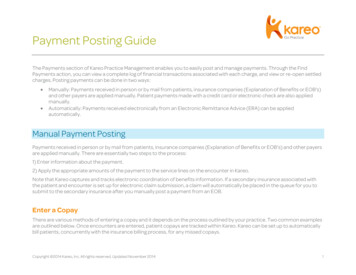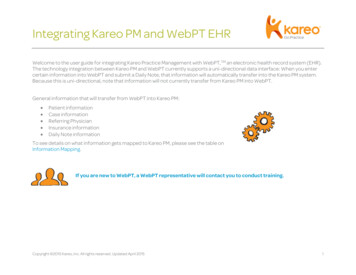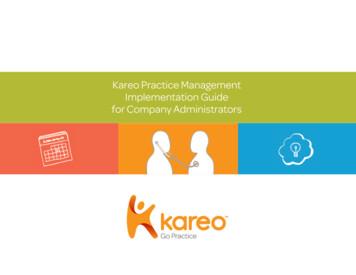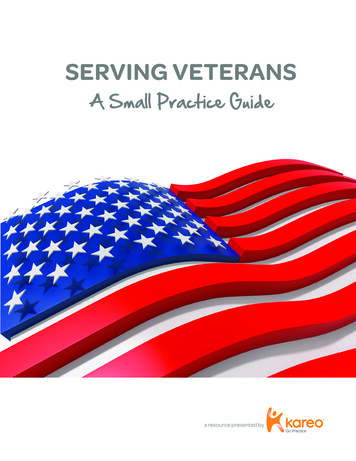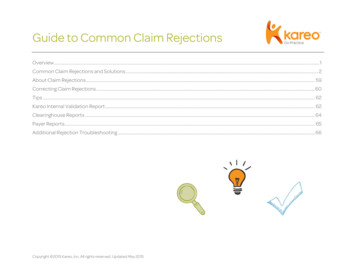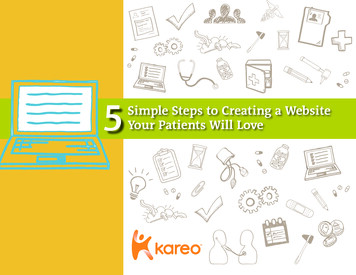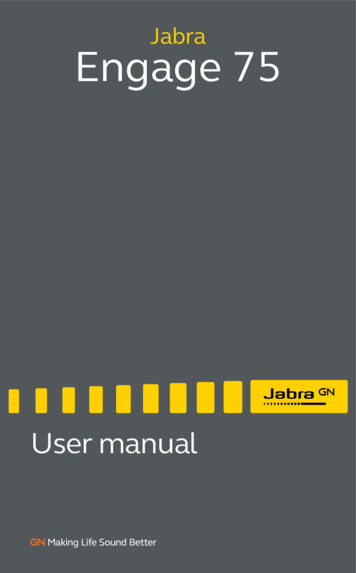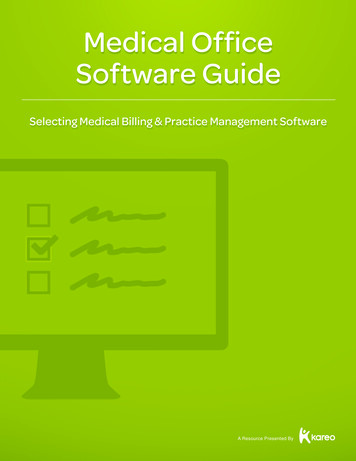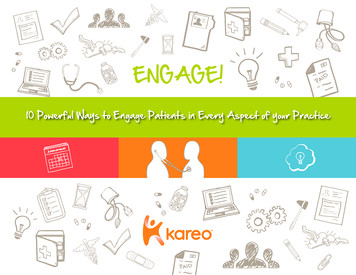
Transcription
ENGAGE!10 Powerful Ways to Engage Patients in Every Aspect of your Practice
Table of ContentsEngaging Your Patients Matters. 3Engaging before the Visit. 5Engaging during the Visit. 7Engaging after the Visit.9The Economic Impact of Patient Engagement. 11Next Steps: Patient-Centered Medical Home. 12References. 142
Engaging Your Patients MattersEngaging Your Patients Matters“The blockbuster drug of the century is an engaged patient.”—Eric Topol, MDPatient engagement is about more than improving care, reducing costs, or attesting for Meaningful Use. It’s aboutyour practice’s bottom line. What would the impact be on your practice if you increased your patient load by 10%?That’s what could happen if you succeed in meeting your patients’ expectations. Patients want to be more involvedin their care, they want to have access to more information, and they will change providers if they aren’t happy.The best way to stay competitive? Improve patient satisfaction and engagement.WHY PATIENT EXPECTATIONS ARE CHANGINGMany patients are paying more of their own healthcare expenses. As they do with other services, they want tofeel like they are getting what they paid for—just like you do. In addition, today’s patients are both connected tothe Internet and educated about health issues. Your patients use the Internet and mobile devices in most otherareas of their lives and want the same kind of access to their healthcare provider. According to Pew Research,59% of US adults say they’ve looked online for health information in the past year.1The era of patients staying with the same provider their entire lives is over. This is not your grandfather’s healthcare.Today, many patients report that they would change providers for better service, lower costs, or moreconnectivity.Don’t take your patients for granted. If they aren’t happy,they are likely to seek care elsewhere.www.kareo.comPatient ActivationYou may have heard the termpatient activation used inconjunction with or in place ofpatient engagement. So what’sthe difference? According tothe Institute for HealthcareImprovement, engagement is“actions that people take fortheir health and to benefit fromcare.” Patient-engagementresearcher Judith Hibbarddescribes activation as,“understanding one’s own rolein the care process and havingthe knowledge, skills, andconfidence to take on thatrole.” They are certainly similarbut not quite the same.3
Engage! 10 Powerful Ways to Engage Patients in Every Aspect of your PracticeWHO IS RESPONSIBLE FOR ENGAGING PATIENTSToday’s patients are footingmore of the bill—as much as25% to 30% out of pocket.According to the CDC’s Centerfor National Health Statistics,their expectations also arechanging:4 62% of patients want tocorrespond online withtheir primary physiciansabout their health. 65% of patients wantappointment remindersvia e-mail. 75% of patients are willingto go online to view theirmedical records.2Patient engagement is not solely the purview of physicians, it does not take place solely in the exam room, noris it focused only on care and outcomes. Because patient engagement and satisfaction are inextricably linked,to maximize your practice’s effectiveness, you must consider all areas of your practice—clinical and nonclinical.NEXT STEPSThink about patient engagement as a spectrum from the minute a patient schedules an appointment to themoment she visits an online patient portal to find her test results. There is value in assessing each step in theprocess to look for ways to improve the patient experience and connect with patients in positive and engagingways. In this guide Kareo offers best practice suggestions to do just that.Like what you read? Look for these buttons to share content with others!
Engaging before the VisitEngaging before the VisitThe minute a patient calls your office, the process of patient engagement begins. Don’t miss a single opportunityto connect with your patients and provide them with a stellar experience.CUSTOMER SERVICE STARTS AT THE FIRST CONTACTCustomer service can make the difference between a happy patient and a patient who goes elsewhere. But it meansmore than simply being warm and friendly. The following suggestions will help you provide excellent service in someof the areas where it can be needed the most: Don’t make people wait. When it can’t be avoided let them know why and apologize. Always ensure privacy when talking to patients in the waiting room, hallways, or exam room. Be responsive to phone calls—don’t leave people waiting too long on hold and call back the same day.Social Media in HealthcareSocial media offers online platforms—blogs, social networking sites such as Facebook and Twitter,community forums, and more—that enable you to listen to the community and engage in onlineconversations with patients or potential patients.Research from HIMSS suggests that the largest patient group using social media is chronically ill patients.Social media provides patients with information and support and offers providers a quick way to getinformation to patients. While many hospitals are now using social media, independent-practicephysicians have been slow to adopt it. While it can be intimidating at the onset, it is a great way to engageyour patients. For more information, visit the HIMSS topic area on social media or visit the Mayo Clinic’sSocial Media Health Network.www.kareo.com5
Engage! 10 Powerful Ways to Engage Patients in Every Aspect of your PracticeYes, You Need a Website!Laurie Morgan, senior consultantand partner at Capko & Morgan,is adamant that every practiceneeds a website. Here are herfour key recommendations:1.If your site isn’t modifiable,it’s time for a new, ContentManagement System (CMS)based site. They are easierto manage and update andregular refreshing helps withsearch-engine optimization(SEO).5 WAYS TO HELP PATIENTS BEFORE THEY STEP THROUGH YOUR DOORFrom simple information about your practice to appointment reminders, there are many ways to help patients feelprepared and informed before a visit: Website. Provide a map and directions to your practice on your website, plus printable versions of commonlyused forms such as Informed Consent, Payment Policies, New Patient Information, and Advanced Directives. Social media. Stay connected with your patients via social media. It’s a way to maintain your relationships andhelp keep patients informed with reminders for flu shots or quick tips for heart disease prevention and the like. Online appointments. Online appointment scheduling 24/7 gives patients the ability to schedule appointmentsat their convenience.2.Initial build should be by apartner that understandsSEO. Eligibility verification. Validating patient eligibility not only helps ensure thatyou get paid, it enables you to give patients a heads-up about their coverageand responsibility so no one is surprised come bill time.3.The site should reflect yourpractice’s philosophy andpersonality, and coordinatewith your printed marketingmaterials. Appointment reminders. Offer your patients phone, email, or text remindersto help ensure they don’t miss appointments. They’ll receive the care theywant, and you’ll avoid empty appointment slots.4.Patients value downloadableforms, appointment settingfeatures, and patient portals.Include these on your site orvia services such as ZocDoc.For more information about howto market your practice , seeLaurie’s webinar, Marketing forMedical Practice Profitability.6Like what you read? Use this button to share content with others!
Engaging during the VisitEngaging during the VisitWhen doctors don’t listen to patients and vice versa, a slew of issues can result: from physicians missing importantcues and misdiagnosing patients to preventable hospital readmissions and poor outcomes because patients didn’tunderstand or follow care guidelines. The problem has become endemic: 80% of what doctors tell patients is forgotten as soon as they leave the office. 50% of what is recalled by patients is incorrect. 40% of malpractice suits cite a breakdown in physician-patient communicationas a cause.3The result of this “low health literacy” is extra time and cost at the practice dealing withunnecessary phone and in-office follow up and as much as 73 billion in healthcarecosts attributed to hospital stays caused by a patient not understanding oradhering to a doctor’s instructions.In addition to issues around patient care and compliance, patients’ demand forphysicians to use an EHR (although they may call it something else) at the pointof care is growing and they want better access to their own medical information. 2 out of 3 people would consider switching to a physician who offersaccess to medical records through a secure internet connection.4 80% of Americans who have access to their health information inan EHR use it.5www.kareo.com7
Engage! 10 Powerful Ways to Engage Patients in Every Aspect of your PracticeEHR ProficiencyFor everyone to get the mostfrom a mobile EHR, the providermust be proficient with it. Getcomfortable with the devicebefore entering an exam room todocument an actual patient visit. Use the device for everydaytasks until you are proficient. Use technology solutionsthat allow gesturing and donot rely on keyboard use. HEADS-UP MEDICINEHeads-up medicine engages patients with and in spite-of technology.It enables a variety of actions to beaccomplished by a simple gesture, finger swipe, or tap rather than diverting your attention with complex navigation,keystrokes, spelling, or editing. As a result, you can focus your attention on your patient, instead of your technology.The use of a truly mobile EHR benefits both the physician and the patient in a variety of ways: It can enhance and expand patient interaction by enabling physicians to maintain eye contact. It helps providers have meaningful conversations with patients, share images and educational materials,drug interactions, and more on the device.Learn shortcuts and bailouts: It can provide care recommendations to improve both preventive care and chronic disease management. It can assist the provider in capturing accurate information efficiently, yet without distraction.- Have a docking stationwith an external keypad It enables providers to print visit summaries and educational materialsfor review with patients before they leave the office.- Practice voice recordingvia a Bluetooth headset It can enable broader patient care beyond the boundaries of the office/office hours.Set up a sequencing to yourdocumentation that matchesyour thought process.Even with all these tools, features and benefits, don’t forget to ask if your patienthas questions! Then, answer them as thoroughly as you can.Use templates customizedto your needs so you can getit to a set of simple gesturesas you document.Physicians who offerheads-up medicinehave a competitiveadvantage whencontracting withpreferred payers andprivate-pay patients!These steps can significantlyreduce documentation time.Nurses using an EHR reportedtime savings of up to 45%.68Like what you read? Use this button to share content with others!
Engaging after the VisitEngaging after the Visit“We need to move from ‘what’s the matter with’ our patientsto ‘what matters to’ our patients.”—James Rickert, MDPatient care and engagement doesn’t stop at the door.Today’s physicians need to offer opportunities thatextend the patient experience outside of the practice and keep patients informed, engaged, and compliant.We suggest the following two ways.1. PATIENT PORTALSPatient portals offer unparalleled access and connectivity for patients. They provide many features that can helpimprove their clinical experience and follow through. Specifically, patient portals enable patients to: Access and download their medical records See their lab test results Request refills Send secure communications to their physicians See and update demographic information Receive statement alerts, review bills, and make online paymentswww.kareo.com9
Engage! 10 Powerful Ways to Engage Patients in Every Aspect of your Practice2. PATIENT PAYMENTSWhat the Open NotesTrial RevealedMany physicians are concernedabout what it means to givepatients access to their visitnotes. The open notes trialshowed that patients wantthis access and believe that itimproves their understandingof both their medical conditionand their treatment compliance. The trail showed: Simplifying the billing and payment process is another important way you can improve the patient experience.Many patients find medical billing confusing and frustrating, especially if they are being treated by multiple providersand receiving a lot of bills. This is often the case for patients with life-threatening and chronic conditions, includingcancer.There are many ways to make this process less stressful: Review the patient’s eligibility and coverage and discuss what the patient may owe. Provide your patient payment policy and set up any special arrangements in advance and in writing. Collect co-pays at the time of service. Offer flexible payments options: cash, check, and credit card. Make sure you can take payments in the office, over the phone, and online.82% of patients openedat least one note. Offer the option for paper or electronic statements. Include a link for online payments on your paper statements.Of those, across threesites, 77–87% reported itmade them feel more incontrol and helped themadhere to medicationrecommendations. If a patient calls with a question about their bill, take the time to answer and make sure they understandbefore you hang up.85% reported that havingaccess to doctor’s noteswould influence theirchoice of providers in thefuture.7“Many people in health care still don’t realize that patientsare the ultimate stakeholder—the ones who have the mostat stake in having good, accurate information at the pointwhere it’s needed.”—Dave deBronkartPatient Advocate and Blogger10Like what you read? Look for these buttons to share content with others!
The Economic Impact of Patient EngagementThe Economic Impact of Patient EngagementEach of your patients represents a lifetime value to your practice. According to the American Academy ofFamily Physicians, the average patient visits their primary care provider 3.19 times a year. Many patients withchronic conditions see their specialist two to four times a year. Cost per visit varies widely by specialty but theestimates generally fall between 100 and 200 per visit. One study of uninsured gave a total per patient amountfor the year of 630.Meaningful Use andPatient Engagement Appointment reminders can reduce no-shows by half—that’s at least one no-show per day for the averagephysician.8 On-demand online appointment scheduling can fill open appointment slots. Offering online payment options can speed patient payments, which now make up 30% of practice A/R. Providing printed education materials, visit summaries and a patient portal, reduces phone calls and otherunnecessary patient follow up, freeing staff for other tasks.Meaningful Use (MU) containsseveral core objectives thatrelate to patient engagement.These include providing visitsummaries, communicatingelectronically with patients,and providing patients withthe ability to download theirmedical record. If you arealready doing these activitiesto engage your patients thatmakes attesting for MU all thatmuch easier. 2014 is the lastyear to get started with MUand avoid the penalties, whichmay be as high as -5% of yourMedicare Part B claims. StartMU now and you can bothavoid the penalty and earn 24,000 in incentives.If your practice prevents one no-show and is able to fill one open appointment a day, that could result in anadditional 200- 300 a day in revenue for the average provider. If you have 1,500 active patients, and you are ableto increase that by 10% through patient referrals, you increase revenue by 75,000 a year.Learn more by visiting Kareo’sMeaningful Use ResourceCenter.For this purpose, we’ll say the average patient sees their doctor three times a year and the doctor is reimbursedaround 500. Over a patient’s lifetime, that equals approximately 25,000. This is probably a conservative estimatebecause patients with chronic conditions such as diabetes, heart disease, or obesity have much higher healthcarecosts.INCREASING ENGAGEMENT CAN BOOST REVENUEThere are many ways that engaging patients and providing improved service can boost your revenue. At the mostbasic level, it can help you retain existing patients and increase referrals from those patients. Each new patientresults in an increase of about 500 a year.Beyond that, many of the tools discussed in this guide provide other potential revenue benefits:Conversely, poor customer service and lack of patient engagement could cost you patients. If you experiencea loss of 5%, you’re looking at a decrease in annual revenue of 37,500!www.kareo.com11
Engage! 10 Powerful Ways to Engage Patients in Every Aspect of your PracticeNext Steps: Patient-CenteredMedical HomeIt’s an understatement to say that things can move slowly in healthcare. So it’s a good sign that in just a few years,the trend towards adoption of a Patient-Centered Medical Home (PCMH) model is steadily growing. According tothe 2013 Great American Physician Survey, conducted by Physicians Practice and sponsored by Kareo, about20% of providers had either already qualified as a PCMH or were transitioning. This data supports a growing sensethat improving patient-care coordination and engaging patients in their wellness has the potential to transformhealthcare.There is not currentlya list of all the payers whooffer incentives for PCMH.To find out if any of yourpayers offer these incentives,run a report of your top fiveto ten payers and contactthem directly.12In 2007, a consortium representing more than 300,000 physicians developed a set of joint principles for the PCMHmodel. These principles were intended to guide the development of a model focused on patient engagement andimproved outcomes. From this initial proposal, recognition programs emerged and the National Committee forQuality Assurance (NCQA) became the most widely accepted PCMH program. It promotes the following goals: Improve the patient experience Recognize clinicians’ efforts Provide confidence for purchasers Value for money spent on quality careSome payers have even implemented bonus programs and payment systemsbased on PCMH recognition.Like what you read? Look for these buttons to share content with others!
Next Steps: The Patient-Centered Home ModelBest Practices for PatientEngagement1.Enhance access and continuityEric Manley, eHealth systemmanager at the Mayo Clinic,and Dr. Simeon Schwartz,president/CEO of WestmedMedical Group in New York,discussed best practices forsuccessful patient engagement at HIMSS 2013.2.Identify and manage patient populationsKey points included:3.Plan and manage care 4.Provide self-care support and community resources5.Track and coordinate careRemember that we arenow in an era in whichpatient care is no longervisit centric.6.Measure and improve performance Engagement must bemeaningful and engagepatients where and whenit is convenient for them. Simply provid
EHR Proficiency For everyone to get the most from a mobile EHR, the provider must be proficient with it. Get comfortable with the device before entering an exam room to document an actual patient visit. Use the device for everyday tasks until you are proficient. Use technology solutions that allow gesturing and do not rely on keyboard use.
